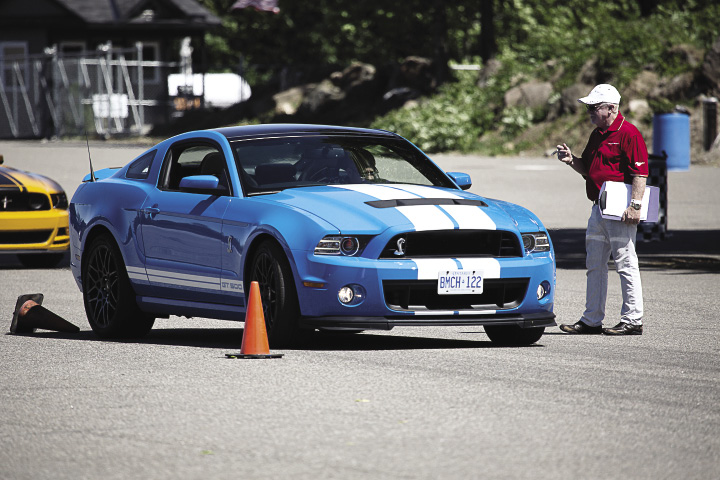2013 Mustang Shelby GT500

If you don’t think the 302 is enough Mustang for you, there’s always the Shelby GT500. Also available in hard and soft top versions, the former starts at $61,500 (again, plus $5,000 for the convertible) and you get basically the same supercharged V8 engine found in the Ford GT supercar, but with improvements, and the venerable Tremec six-speed manual transmission with revised gearing.
For starters, engine displacement is now 5.8 litres (compared to 5.4 on 2010-12 models) thanks to larger-bore pistons. There’s a bigger, more-efficient 2.3-litre supercharger that helps net 662 hp and 631 knee-wobbling torques and catapults the car from zero-to-96.6 km/h (60 mph) in 3.7 seconds – almost twice as fast as the Focus ST – en route to its 320 km/h top speed. The outgoing 5.4-litre V8 makes only 550 hp and 510 lb-ft by the way.
Virtually every part of the 2013 GT500 powertrain is optimized for the 20% increase in horsepower and 24% increase in torque vis a vis a new cross-drilled block and heads, updated camshaft profiles, a new carbon fibre driveshaft and upgraded clutch, transmission and axles. The entire cooling system has been overhauled with a larger cooling fan, fan shroud with high-speed pressure-relief doors, a more efficient intercooler, higher-flow intercooler pump and a 36% larger intercooler heat exchanger. Perhaps even more impressive is the fact the 2013 GT500 squeaks under the “gas guzzler tax” with fuel economy figures – 13.9 and 8.3 L/100 km in the city and highway, respectively – similar to that of a mid-size SUV.
A new Brembo system with six-piston front calipers plus larger front and rear rotors resists brake fade better while new pads offer more aggressive initial bite for the road or track. Also new for 2013 is an optional Performance Package featuring adjustable Bilstein dampers and a Torsen limited-slip differential to help the rear suspension better deliver maximum torque and traction and longer under track conditions. All vehicle configurations come with 19-inch front and 20-inch rear wheels coupled with Goodyear Eagle F1 SuperCar G:2 ultra high-performance tires.
A launch control feature with user-changeable RPM setting is included to help achieve those acceleration numbers; however, with the Track Apps’ launch RPM set to 3,500 rpm, I could only muster 4.3 seconds (in a half dozen or so attempts at the track) as proven by the data-logging capabilities. Once properly set and ready (with the GT500’s heavy clutch fully-depressed and mashing the gas pedal), the charged V8 revs up and holds at the preset RPM. Drop the clutch within five seconds and the Shelby hooks up and takes off like a bat out of hell, pulling the occupants into their seats.
Out on the racetrack, it hauls ass out of 90-degree corners and bombs down long straightaways with such ease. The Brembos do instill confidence at the end of those straights and the car is pretty good in the corners. It does tend to understeer, but that isn’t such a bad thing when you’re out on the track.
Conclusion
The GT500 may be the fastest, most-powerful Mustang to date, but it’s only marginally quicker than its stablemate the Boss 302, which is lighter, more responsive and better-balanced on the track. Of course, it even comes as a track-only version called the Laguna Seca Edition. Neither car comes cheap though. And, perhaps by the time you’ve built and priced one (or the other) out exactly the way you’d like on the Ford.ca site, you could probably put together two Focus STs for about the same price and have just as much fun.
- << Prev
- Next






















